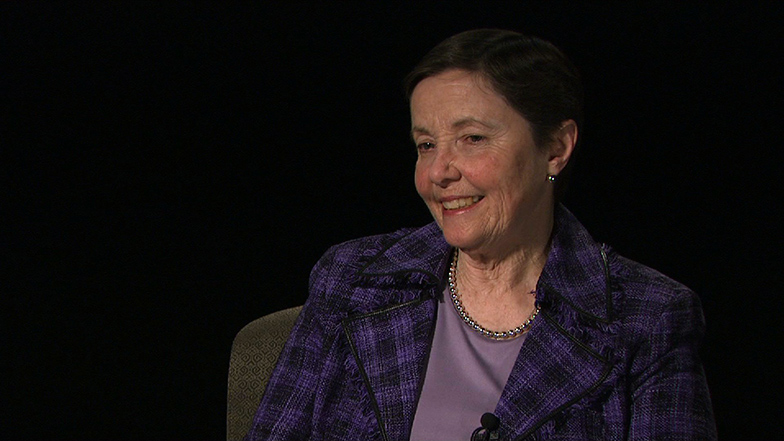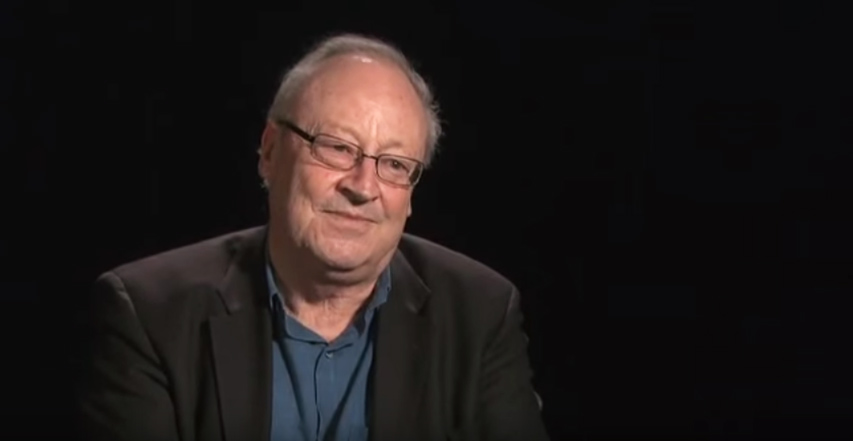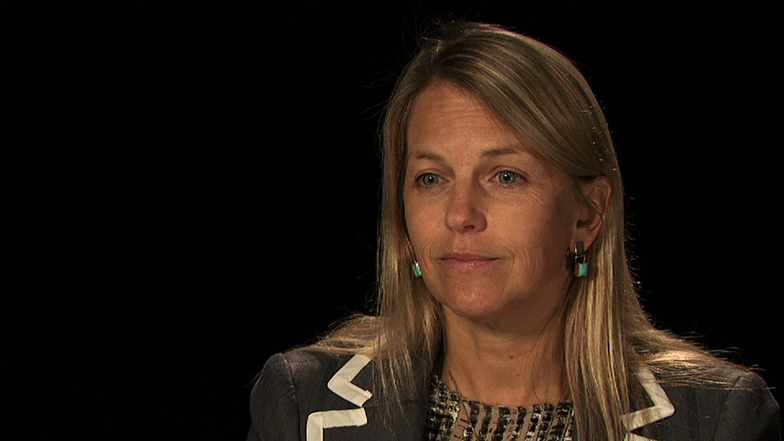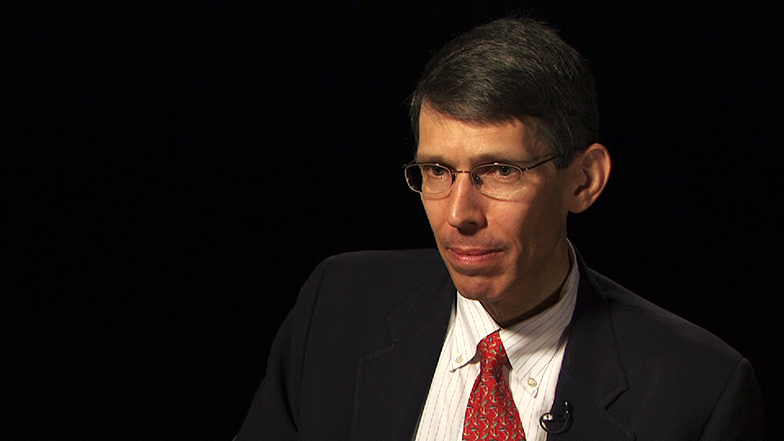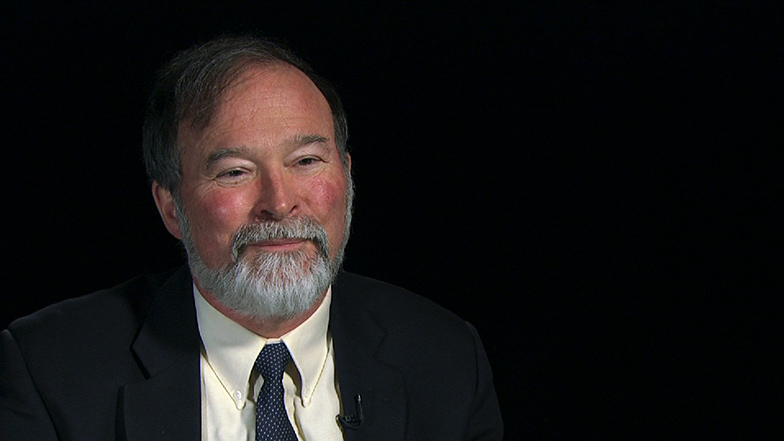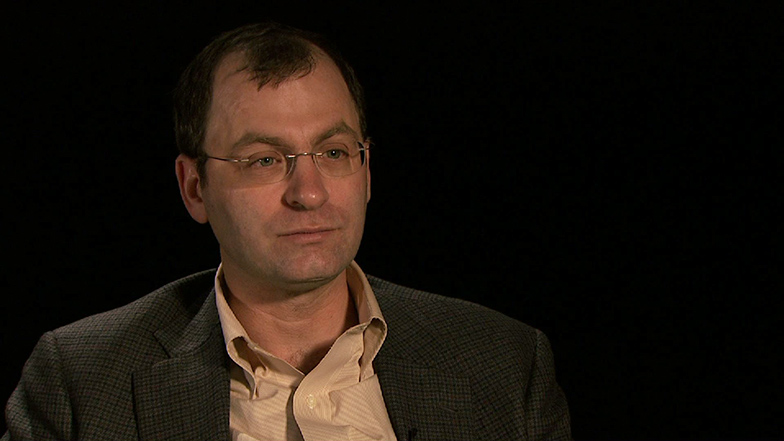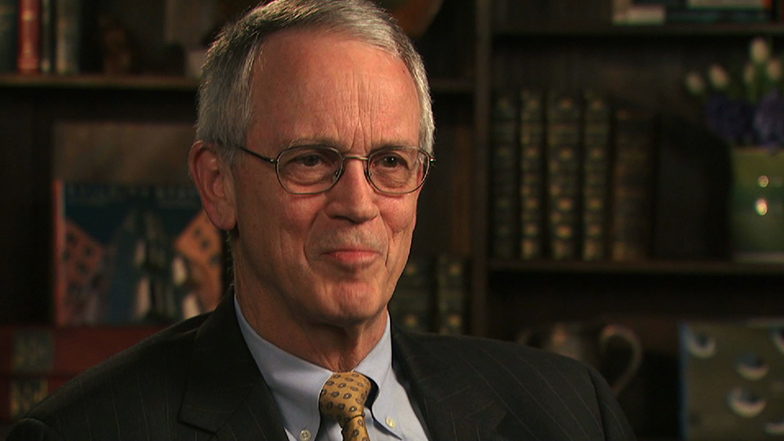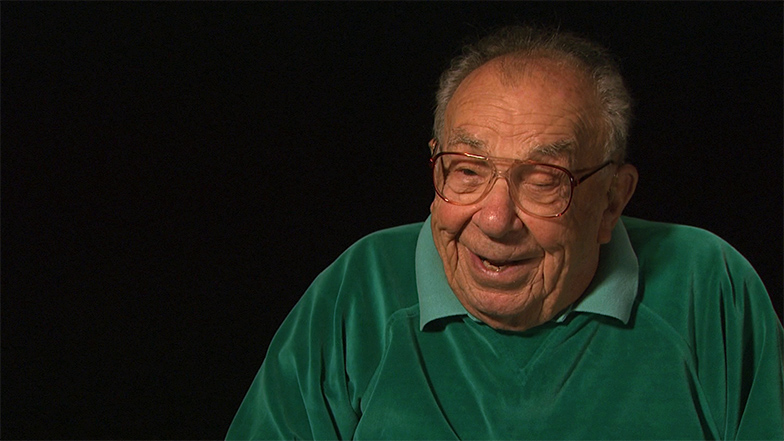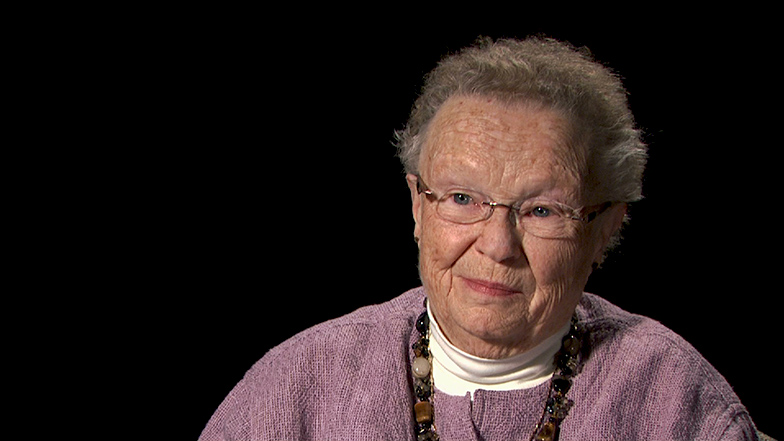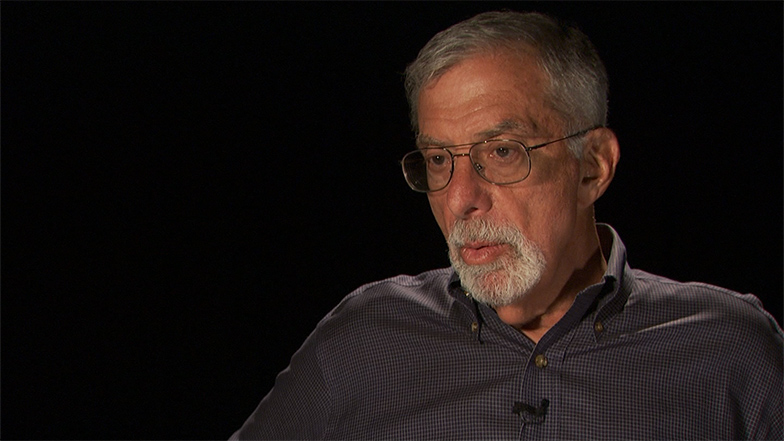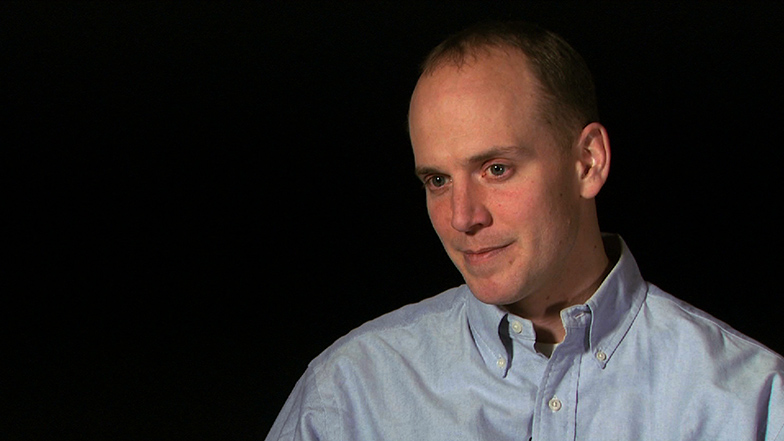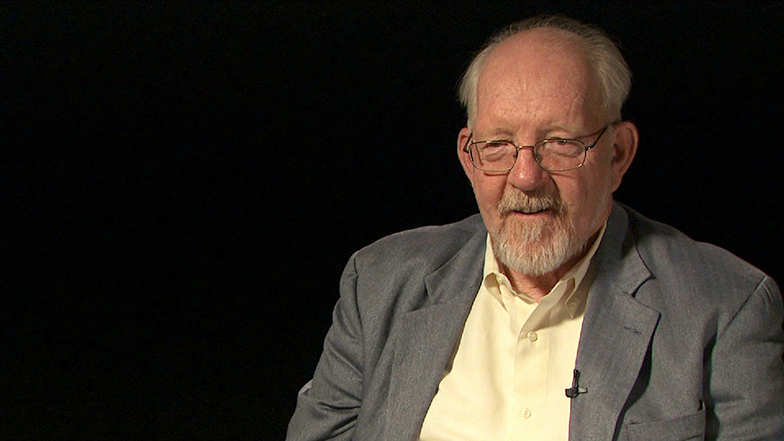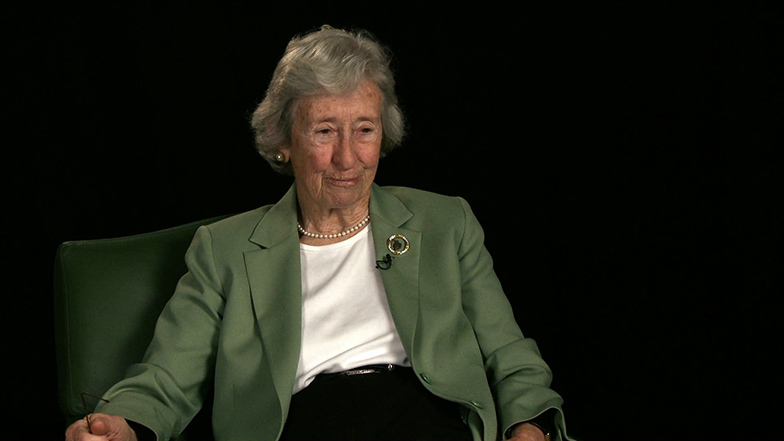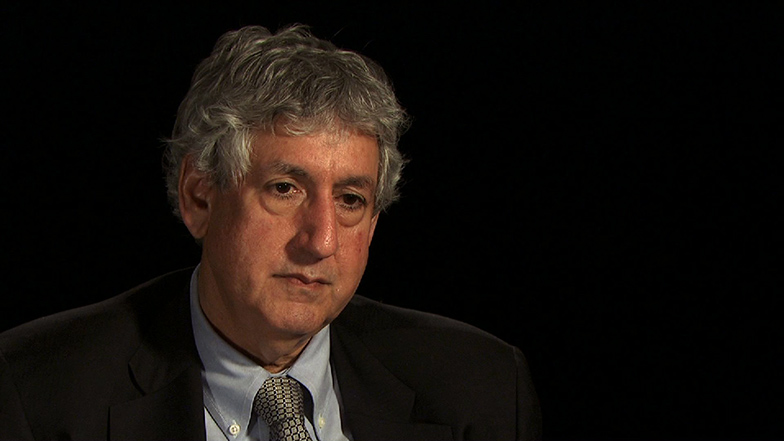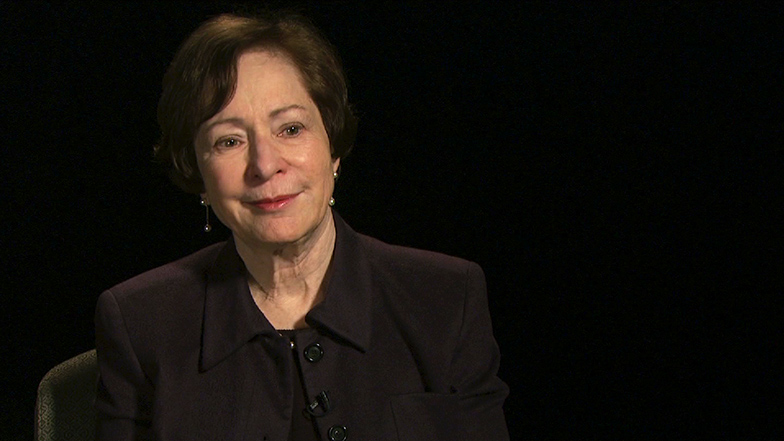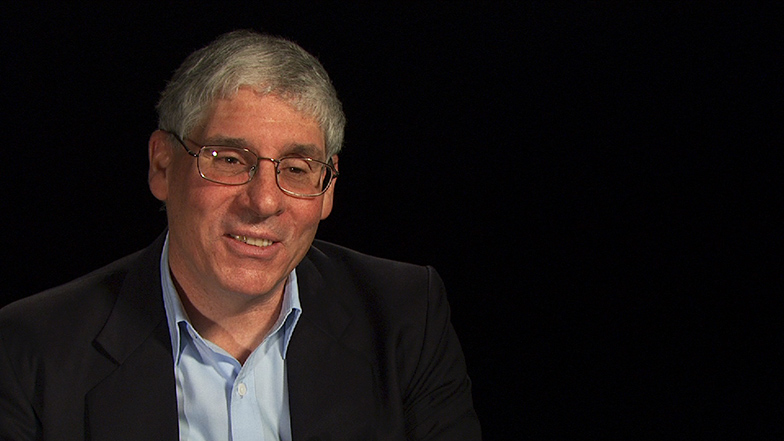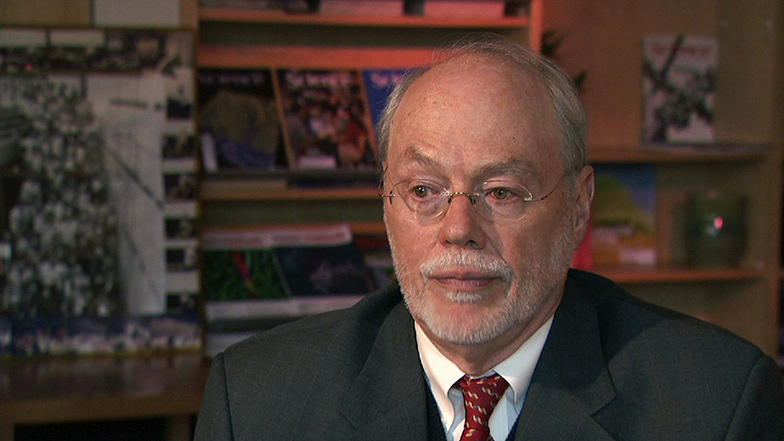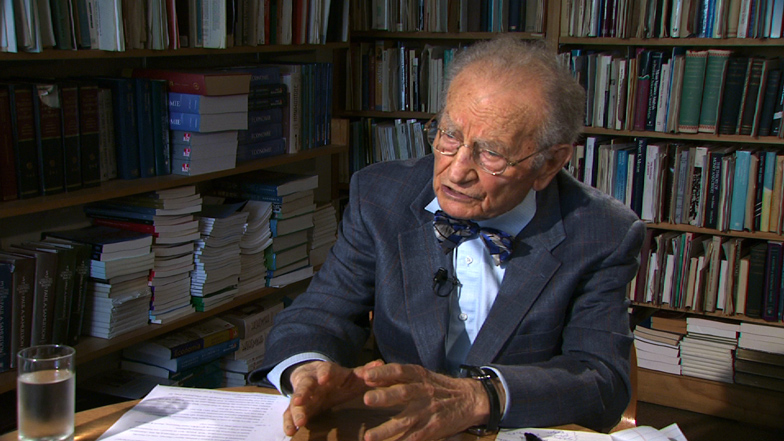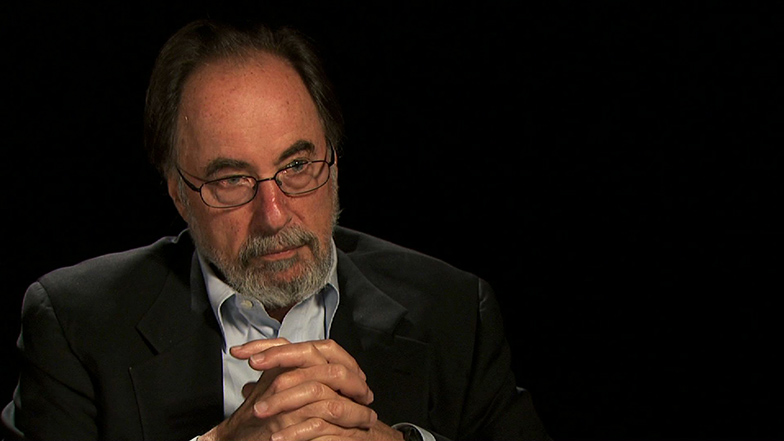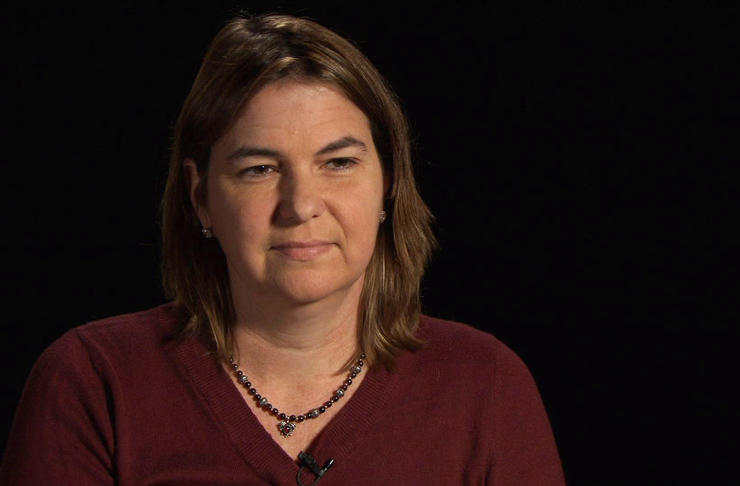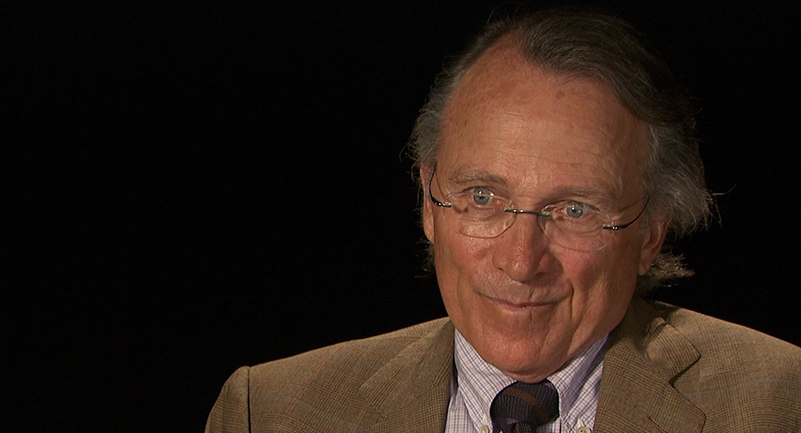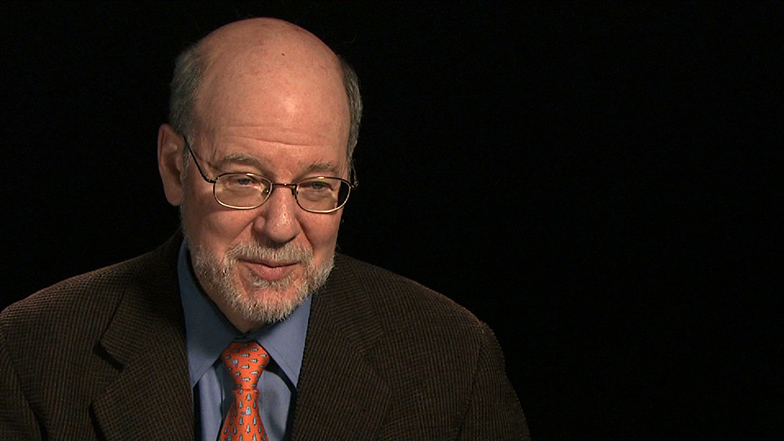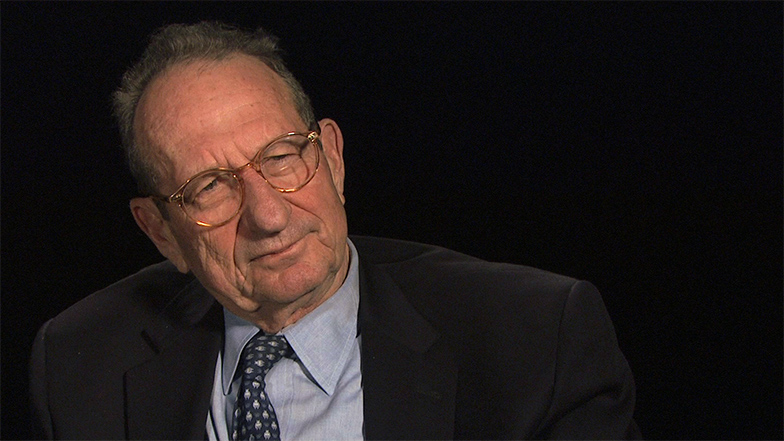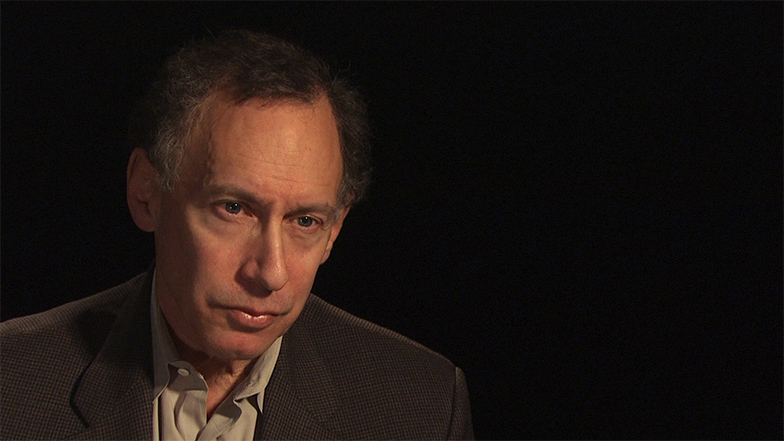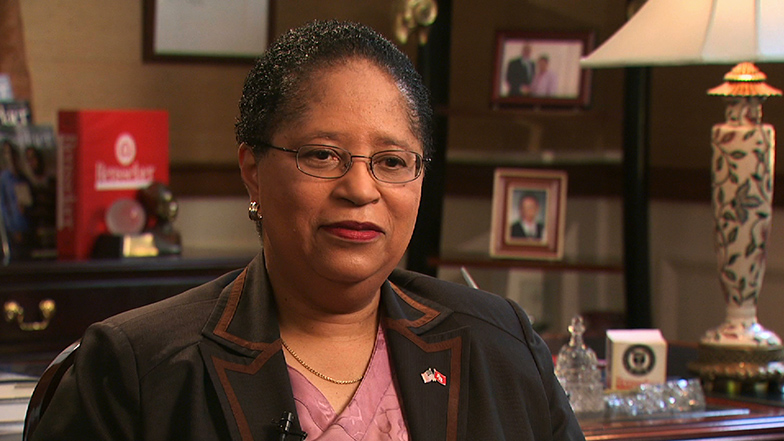J. Kim Vandiver
INTERVIEWER: This is the MIT 150th Anniversary celebration interview with Professor J. Kim Vandiver. And let me start by asking you where you grew up?
VANDIVER: I was born in Spokane, Washington and grew up in Yakima, Washington, which is right in the central part of the state; sort of the desert country. Worked in the apple orchards as a kid and spent a lot of time outdoors with my father.
INTERVIEWER: Tell me a little bit about your family.
VANDIVER: I have two older sisters, my father was an engineer with a telephone company, and my mother was trained as a schoolteacher, and in my growing up years taught piano in the home. So I grew up with piano music in the background all the time, and to this day I still just really enjoy hearing the piano.
INTERVIEWER: That's why your iPod list is all classical. Are there any particular influences in your childhood which you think contributed to the career path you took?
VANDIVER: Well, my father was an engineer with the telephone company. He was one of these people who grew up as a kid on a homestead; lived on the ranch. Very self sufficient, could fix anything, and he passed that on to me. And so my first car was a 1949 Willys Jeep, which I drove to school when I was in high school. But the condition was if you're going to drive it you're going to maintain it and fix it. So I grew up with that kind of a hands-on, doing everything attitude around.
INTERVIEWER: Did you have a particular interest in science when you were in school?
VANDIVER: I developed an interest in science and engineering kinds of things very early, it just happened, probably a lot because of my father's influence. He liked to build things. I started building things. I made my first go-cart out of parts from a push lawnmower and an old motor. So I enjoyed building things. I was very active in the late 50s, early 60s. When Sputnik went up in 1957 I was building rockets in the backyard and blowing the bottom out of the bathroom sink with firecrackers and things that my mother of course really enjoyed. I'm probably lucky that I still have all fingers and eyes and toes today because of my childhood, but I learned a lot.
INTERVIEWER: So how did you wind up at Harvey Mudd when you went to college?
VANDIVER: I knew I wanted to go to a school that had science and engineering. And I sat down in those days with the College Entrance Examination Board Booklet of Colleges book. It's this thick like a telephone book. I went through it page by page and I bumped into Harvey Mudd College. And I went there to visit; my brother-in-law dropped me off and I'm just walking down the street in Claremont and a white-haired gentleman in an old Chevy drove up and rolled down the window and he says, you look like you're new here. And I said, yeah. And he said, jump in, I'll show you around. And so he turned out to be a retired history professor from Pomona and I was on the wrong end of campus and he drove me all around to drop me off at Harvey Mudd. And I decided I kind of liked the place; if the people were like this, this would be a good place to go.
INTERVIEWER: And what made you decide to major in engineering?
VANDIVER: Well, I had a chemistry teacher in high school that I really liked, and so I arrived and my father was an engineer for the telephone company. And I thought his job was pretty boring, so I was not going to be an engineer. I thought I'd be a chemist because I liked my chemistry teacher. So I got to Harvey Mudd and it took my first chemistry professor about two weeks to convince me that being a chemist was a really dumb idea. And when I was a senior the dean of students got out of his little black book and said, Kim, would you like to know what I wrote about you when you were a freshmen? I said, sure. He opens his book and it says, if we don't get Kim interested in engineering, we'll lose him. They gave aptitude tests in those days. They knew what you were like and what you were interested in. And he was right, by the end of my freshman year I began to realize that engineering was really the right thing for me, and I started majoring in engineering.
INTERVIEWER: Do you think it was just that you had the inherent skill set for engineering? What was it that made you a good candidate for engineering?
VANDIVER: In hindsight now, what made me interested and enjoy engineering is I liked that instant gratification that comes from building something, seeing it work, seeing it help somebody, seeing it please somebody. These are things that engineers appreciate, which don't always come in pure science where you can spend a long, long time working a problem. But I really like that more interaction and give and take that comes from working on engineering problems when you're working with other people and solving problems that help them.
INTERVIEWER: How did you wind up then from Harvey Mudd to MIT for graduate school?
VANDIVER: I came to MIT-- I got interested in ocean engineering because my brother-in-law was in atmospheric physics and oceanography. I did scuba diving at the time; I liked the oceans. I liked boats, but I didn't grow up with an initial passion for being an ocean engineer. As I was looking around for interesting things to do I decided being an engineer and combining it with activities in the ocean would be fun, and so I looked for schools, universities that had graduate programs in ocean engineering. And there were four or five at the time, and MIT-- it was in the Naval Architecture Department at MIT. So I applied here and came here in 1968 as a grad student.
INTERVIEWER: What was it about MIT that drew you?
VANDIVER: Well, initially when I was applying as an undergraduate to college, I'd grown up in the West Coast, I applied to no East Coast colleges. And the choice to come to MIT in graduate school was just really made by looking at the four or five different programs in the country and comparing them and decided that looking like the one at MIT was best suited to me. I really didn't know much about MIT, but I came to try it out.
INTERVIEWER: Do you remember what your first impressions were of the culture, the students, the faculty?
VANDIVER: I was fortunate and so in my first impressions I applied for a summer fellowship at Woods Hole. So I graduated from Harvey Mudd in June of 1968 and two weeks later I arrived at Woods Hole for a summer fellowship. Now Woods Hole and MIT had no joint program at the time, but it was just nearby and it was related to the oceans. And I was thrown in with a bunch of other grad students from all around the country, had a wonderful time, met wonderful people at Woods Hole, so that was a fantastic start. So I arrived then, on campus, the end of August of that summer already knowing a number of people, being comfortable with living in New England. It was a great start.
INTERVIEWER: Were there ways in which MIT was different academically than what you were coming from?
VANDIVER: MIT and Harvey Mudd in those days in undergraduate programs were very similar. Lots and lots of required subjects, so I had at Harvey Mudd-- every engineer had six semesters of math, four semesters of physics, three semesters of chemistry, and then you just started taking your engineering subjects. MIT was a lot like that in those days. Very hard, you had to learn some real time management skills and discipline and get the work done. So I think they were actually very similar places. When I applied one of my favorite professors at Harvey Mudd wrote a recommendation for me, and I don't know if I asked him what he wrote, but he volunteered. He told me what he wrote. He said, I just told them you were as good as Bob Stuart. And Bob Stuart was a student who had gone the year before to the same department at MIT and he came here and got straight A's in all of his graduate subjects the first year he was here. And so that was a pretty good recommendation. So I found it similar, and I actually found graduate school easier than undergraduate school.
INTERVIEWER: What made you decide to stay at MIT for your PhD?
VANDIVER: Well, that year, 1968, 1969-- in those days, if you graduated from college in 1968 and you were healthy and able bodied, you were in the Army. It was before the draft lottery, but it was after all the loopholes had been closed in the draft. So I was holding off my draft board, desperately trying to get one year in as a grad student just to get a Master's degree and get started. So I knew I was on my way into the Army and so I turned my Master's thesis in the summer of 1969-- in August-- and 10 days later I had to report back in California for an induction physical. So then there was a break. I had a two and a half year break while I was in the Army and before I came back to graduate school. So if you don't mind me diverting, I'll tell a little story here.
And that is on the basis of having a Master's degree in engineering, I applied for a direct commission in the Army. And so later that fall of '69 I got my fifth notice to report to the draft. And in the same week I got a letter that said if you want to be an instant second lieutenant go down to your local army reserve and raise your right hand. And the letter said if you decide to become a second lieutenant, you must agree to go to Vietnam. That was the condition. So I went down. I said, I might as well be a second lieutenant, went down, and swore in. So in January of 1970 I entered the Army and went to Fort Belvoir, Virginia for engineering officer basic training. And then I served a year in Vietnam, learned a lot of really interesting things, was very fortunate, and arrived back here on campus in January of 1972.
INTERVIEWER: Can you describe your graduate school experience at MIT?
VANDIVER: Hadn't thought about that in a long time. I did think about it when I was sitting at my desk in Vietnam saying, I have a Master's degree, do I want to go back and do all the work of a PhD? When I'd left I wasn't so sure, but Vietnam could be really boring and it did give you some time to think about what you wanted to do when you grew up. And by the time I'd finish my tour, I decided I really did want to go back, and by that time the joint program with Woods Hole and MIT had started up. That summer of 1969 when I was doing my Master's thesis, I actually did the research work at Woods Hole. And I needed a summer fellowship to help pay the way. And the head of the Department of Naval Architecture at the time, Alfred Keil, said, well, I'll pay your fellowship for the summer, but I want you to do something for me. He said, I want you to interview people at Woods Hole and find out how they feel about having a joint program.
And so I did. I went around and knocked on the doors of all sorts of people-- oceanographers and all kinds of people and found out about a third of the people wanted absolutely nothing to do with it. They'd gone there to get away from that kind of the academics and teaching. About a third of the people were wildly supportive and about a third of the people really didn't care. So I reported that back to Professor Kyle but it got me interested-- I really began to know a lot about what this proposal of a joint program was. So while I was sitting at my desk in Nha Trang Vietnam thinking about whether or not to go back to grad school, I thought about the joint program. And by the time I was ready to come back, it was up and running, so I applied to the joint program from Vietnam saying I want to come back to the joint program and was fortunately admitted.
INTERVIEWER: How did you wind up joining the faculty at MIT?
VANDIVER: How'd I join the faculty? Well, I had a great three and a half years then on my second tour as a grad student. Came back, in fact, I didn't know what I wanted-- I didn't, let me start that over. Came back. In order to do a PhD you have to find a PhD thesis topic. And you go around and talk to a bunch of different faculty and find out what they have to work on. And I didn't like anything I saw. When you're entering your PhD program at MIT you have to take doctoral qualifying exams. And I took my exams in May of 1972. That meant my first semester back I was just studying like crazy, and I was going to take one subject though just for fun. And I went and talked to Doc Edgerton and convinced him to let me take his undergraduate high-speed photography course because I'd taken up photography as a hobby in Vietnam. And he said, you know, sure, I'll let anybody in. So I took that course and had an absolute blast taking it. I'd had lots of laboratory subjects, so I had a real advantage over the undergraduate students. It was just a lark to do that subject.
So that summer I had passed the doctoral exams in May, didn't have a thesis topic, and Doc Edgerton needed a teaching assistant for the following year. So this is one of those things-- life-changing events that happen. So I went to work for Doc Edgerton in the Electrical Engineering Department as his T.A. And when I arrived on campus from having been at Woods Hole for the summer, came and arrived in the first week of September and there's a letter waiting for me. And Doc wasn't in, but he said, Kim, I'll be back in a week or so but why don't you think about doing a project while you are being my T.A? He said, something I've never taken a picture of or a kind of photography is color schlieren photography. Now schlieren photography had been used by the aeronautics industry to take pictures in supersonic wind tunnels. So we can see those models where they have the shock waves all showing and that kind of thing. That's schlieren photography. So I said, OK, I'll give this a try. And so I went to the library and read up on the methods and built my first system. And by the end of September I'd taken my first schlieren photograph and I walked in and handed it to Doc Edgerton. And he had this little 10 power loop and he'd hold it up. These were 35 millimeter slides and he'd say, Van, looks out of focus to me.
And I went a month later, had another whole setup built and took the pictures. Van, I don't like the color. So January I was getting desperate, and I was looking at a copy of Scientific American and there used to be a wonderful section in it called "The Amateur Scientist" and a grad student in Tennessee had come up with a new way of doing schlieren. I tried it, set it up, built it, took the pictures, and in January walked into Doc and showed him I think-- I brought this-- this is the picture. Maybe this one or very much like it. That's a bullet passing through the heat above the candle and you can see the shock wave and all the hot air. Took that picture in, Doc holds up his loop and he says, Van, I think you've got it. So in five months of work, the most wonderful words I'd heard in years. So I took these pictures, Doc really liked them, and there's another story which I can tell behind that. I'll finish answering the question about how I got into what I did in joining the faculty.
That year gave me time to look around for a good thesis topic. And without a good thesis topic you don't do work that will really impress people. And I found a topic I really liked. One of my many mentors was a senior professor in ocean engineering named Harvey Evans. I was his last doctoral student and I had talked to him earlier. I told them what I was interested in and so many months passed. He came back to me and says, Kim, I think I have something. He had me write the proposal that went to the American Bureau of Shipping. They then funded it. As I did the doctoral work, he essentially trained me to be a professor. At least to figure out how to do research, how to write proposals, how to manage the budgets. And he had me do it all as if I were basically a junior professor.
And so he basically mentored me through what it takes to do research as a professor. So that topic happened to be on the dynamics, the vibration of offshore structures. And it lead to my first professional publication-- actually, my second. There's another story which I want to tell. So my second, but my first professional publication in ocean engineering then was at the Offshore Technology Conference in 1975. I had finished my PhD in January of that year and it turns out that the topic was a really hot one in the industry at the time. It had to do with developing methods that you could detect failures in members underwater of fixed offshore platforms.
In 1975 the oil well drilling was done from platforms that looked like big television towers sitting on the bottom. And if they developed fatigue or cracks they would become potential failure problems. And that was a hot topic. That my first paper drew lots of attention. Essentially, there was opening in the department at the time for an assistant professor position to which I applied, and that's how I got my first job. But you can see the sequence of events, if Edgerton hadn't given me the chance to take a year to find a really good topic, those things wouldn't have happened.
INTERVIEWER: No, all those other dominos.
VANDIVER: Yeah. Let me tell you another story. So Doc really liked these schlieren photographs. And I took a lot of them. We thought of everything we could take pictures of-- ice cubes floating in water, breathing-- you can see the air coming out of your mouth, and everything we could do. And then he said, Kim, you should write this up and go give a paper. And he said, the place you're going to give the paper is at the 11th International Congress on High-speed Photography. Well, Edgerton is the father of high-speed photography, and so if you get to go with Edgerton to that place you're with the man. And that was the situation I was in. So I wrote the paper and you had to present the paper. This was at University College in London in the summer of 1974 or 1973. And Doc said, you know, those pictures are really gorgeous. He had about a dozen of them enlarged-- 16 by 20's-- mounted, sent them ahead to the conference so when we arrived there they were all up in a gallery that anybody walking into the conference could go around and see. And I gave the talk and the talk was a very typical Edgerton talk. I mean I studied Edgerton and he was a wonderful showman. And so I just showed dozens of beautiful photographs, and after the talk a man came up to me and he'd seen the pictures in the gallery and he said, Dr. Vandiver, I'd really like to be able to use one your pictures. I said, sure. Let's talk. Well that picture ended up on the cover of Nature magazine. And my very first article ever was a little piece on the inside about how those pictures were taken. So that was in fact, my first professional publication. I was still a grad student at the time. And when it comes to getting positions as an assistant professor at MIT, it's not bad to have your first article be a cover photograph in Nature magazine.
INTERVIEWER: It must have been very heady experiences.
VANDIVER: Oh, it was. Actually, it was awkward at times because Doc was the father of modern high-speed photography, and everybody assumed that I was his protégé and I was going to continue in his footsteps. He was about 70 at the time. He was 73 or 74. No, he was 71. But I wasn't. It would've been absolutely foolish to do that. Nobody could replace Edgerton. And in fact, I was an ocean engineer, so it's a little different-- I just was more or less quiet about it with all these people at this conference. I'd just nod my head, but-- it was heady, but I knew that you can only take that just so far. Doc's influence on me and the things that he did that helped mentor my career were just stupendous.
INTERVIEWER: When you joined the faculty was it a different experience or a different view of MIT than being a student? Or did it seem like just a natural progression?
VANDIVER: I think it was a natural progression. It was different, I'd had this really excellent experience as a doctoral student because of the mentoring I got from Harvey Evans just showing me the ropes of how you would do it as a faculty member. I recall the hardest part of being a junior faculty member and the difference between being a faculty member and being a graduate student is that you have to become the mentor. And that's pretty new to you, so now you're choosing new grad students, and you're helping them through their PhDs. And you're having to sit back and let them do the work, and you're having to guide them through their first papers. That's the biggest change, is letting go of doing it yourself.
INTERVIEWER: Were there other mentors that you had at MIT?
VANDIVER: Lots of people helped me along the way. I value good teaching, and I studied people that I liked. When I was in class listening to them talk, you know, why do I like the way this person teaches me and what can I learn from this so that I can become a better teacher myself? There was a person who I just thought had absolutely beautiful blackboard and classroom technique of the style of class where you're putting things on the blackboard and explaining them. And that was Steve Crandall, who was a professor in mechanical engineering. And when it came to giving a public presentation, Doc was the master showman and I watched him and said, OK, what works when he's doing that? And like I said, Harvey Evans helped me become a professor. My first department head was Ira Dyer, and he was a really good department head and gave me great advice. Helped me find my first places to write proposals to and get my own research money. People like that don't often get much credit, but he steered me to places that turned out to be good steers and they paid off. Good help.
INTERVIEWER: Since you made that study of teaching, do you have a way that you define what good teaching is or the characteristics of a good teacher?
VANDIVER: I'm going to make you ask me that question again.
INTERVIEWER: OK.
VANDIVER: Because I want to tell a story that has to do with mentors. This one's really unusual. As I said, I've had many good mentors, but I had just joined the faculty. It was early in 1975 and Professor Doug Carmichael who was in my department said, Kim, I know you're interested in vibration and things like that. I have a project you might be interested in. And it was a project on a subject called flow induced vibration. So if you have a mooring line on a boat and the tides coming by, the line will sit there and shake. And that's because of the turbulence in the wake of that mooring line. And he was doing some work for the Navy, the Navy was interested on the vibration of cables and things like that. But he literally gave me this research project. He says, I'm too busy. I don't have time to do. You take it over. And he essentially made me the principal investigator. He and I went with a bunch of students to Castine, Maine, where the Maine Maritime Academy is. We had a summer research experience for our undergraduates, and I went along and helped with that, and did experiments on this topic. Well that topic has turned out to be my principle research topic for 35 years. I've been doing it ever since and I'm a world's expert on flow induced vibration of long, slender things in the ocean. And that was because that faculty member gave me a project that he'd written the proposal for.
INTERVIEWER: That's a great story.
VANDIVER: Yeah, and he gets a lot of credit. He's a wonderful fellow.
INTERVIEWER: OK, so I'm going to re-ask my question. Since you've studied techniques of teaching, what is it that you think makes a good teacher?
VANDIVER: Lots of things make a good teacher, but I think the most important one is you do have to care about your students and care about your students' learning. So that means you have to listen to your students and you have to become a good observer of your students. So if you're explaining something on a blackboard and you see-- you learn to recognize an I don't get it glazed look. And you can either just go on or you can stop and do something about it. So that's one of the things that I learned to do early, was read my students and figure out when they weren't staying with me. And I also, I think adopted an attitude very early that most lecturers at MIT, the lecturers teach to the top 10 or 20 percent of the students. And that means that in most lectures at MIT, probably more than half the students are not following it. That doesn't work for me. I still struggle with this after 35 years, of how to teach a group of students where you have the superstars who want to go fast, and then you have lots of students in the middle who need it at a little bit slower pace. How do you teach to the middle and keep the superstars happy? So I'm still struggling with that one.
INTERVIEWER: Oh, I was going to say, how do you?
VANDIVER: Well, with small classes-- Ocean Engineering was a small department and I had classes that varied in size from seven or eight to 50. And with the smaller classes you could give more individual attention. You could figure out ways to do it. You could work on it in recitation sections if they didn't get it in lecture. My teaching style also is, I learned early what is commonplace in K-12 education today. To realize that people have different styles of learning, and that some like the equations, that some like to see the real thing-- and I'm like that. I need to see and feel the real thing in order to understand it, and then the equations make sense to me. So one of the things that I taught for many, many years, and still do is, mechanical vibration. So anything that makes noise in the world has vibration, and so there's lots of things around us-- and it was a subject I really liked to teach. To this day, I try not to walk into even a regular lecture without carrying something with me that is a demonstration of what it is that I want to talk about. I'd try to craft lectures so that in the course of the lecture I appealed to at least three different styles of learning. And so in fact, I'll tell another story.
So I'd been teaching a number of years-- I should have brought another little prop, but we all know what a guitar string or a piano string does. You pluck it, it vibrates, and it makes sound. So in my second year at Harvey Mudd, a physics professor named Stoddard gave a lecture on the vibrating string. And I attended the lecture and took good notes, but I walked out of that lecture saying, wow, that was a great lecture. And 15 years had passed, and I had given the lecture before on the vibrating string, but I wasn't satisfied with it. And I said, you know, I'm going to go back and look at those notes and try to figure out why I thought that was such a great lecture. So I went back and did it, and I then crafted my own lecture, brought a demo, did many of the same things he did, and did the lecture and had a student come up to me afterwards saying, you know, that was the most amazing lecture I have ever seen.
INTERVIEWER: Just what you wanted to hear.
VANDIVER: Right. And it wasn't mine. You know, I borrowed it from Professor Stoddard.
INTERVIEWER: So I'd like to talk a little bit about each of your areas of interest. So why don't we start with dynamics of offshore structures? You've said a little bit about the vibrations, is there anything to add to that or talk about why you're interested in it or why you've stayed interested in it?
VANDIVER: So I got involved in dynamics of offshore structures in my PhD thesis. And so that first professional ocean engineering paper was about using measurements of vibration to tell you whether or not there was structural damage. Turned out actually not to work, but showing that why it wouldn't work was as important as that it could work.
I was interested in vibration. I'd had a wonderful teacher who taught me about basic vibration when I was an undergraduate and that's why I went looking for a PhD thesis involving dynamics. The PhD thesis led to that wonderful gift from Professor Carmichael who said, you know, I have this project on flow induced vibration, maybe you'd like to take a look at that. And that turns out to be a problem that just never goes away. So we have this failure in the Gulf of Mexico right now and the pipe that connects that floating drilling ship with the blowout preventer on the bottom is 5,000 feet long and 21 inches in diameter. If the current flows by it, it'll vibrate. And I've been studying that problem for 35 years. And instead of like many engineering problems, you study them for two or three years, you solve it, and you go on to the next one. This one, the frontier in the industry justs kept getting into deeper water, bigger things, and you had to get better and better and better with your solutions. So we had crude solutions in 1980, better ones by 1990, and about 1990, one of my doctoral students and I wrote a computer program that predicts the fatigue life of pipes like the one connecting the ship to the BOP as a function of the expected ocean currents. And that program, which is called SHEAR7 has been around now for 17 years. We keep improving it, but it's basically the industry standard program for that purpose. So the continuing advancing of the frontiers kept me interested in the dynamics problems in the ocean.
INTERVIEWER: OK. You're still doing the photography?
VANDIVER: I don't do the color schlieren photography that I did when I was Doc's T.A. I occasionally do it when-- well, every year I give talks to the students who are taking high-speed photography at the Edgerton Center. And so I brush off the equipment and then students think of applications and things they would like to try. So I act as a consultant, and I've consulted on a few other doctoral student projects around MIT using those techniques. But I don't often go in and take pictures of my own anymore; there's too many other interesting things going on.
INTERVIEWER: Energy and oil and gas exploration.
VANDIVER: And? What do you want to know about them?
INTERVIEWER: I want to know what is it you're interested in, why you're interested in it?
VANDIVER: Well, I'm interested in ocean engineering problems in deep water, and there are two major sources of support and problems in the world. The US Navy in the United States and doing things in the ocean with cables and so forth and the offshore oil industry. And beyond that, there's not much money out there to support activities. And I've worked with both over the years doing dynamics problems. So that's primarily the motivation there.
INTERVIEWER: Ocean Engineering?
VANDIVER: Ocean engineering in general? Well, I like the oceans and you develop a-- once you get started in a field, you develop a group of peers and colleagues who you get to know pretty well. And I like my relationships with my colleagues. And then they pick up the phone and call you and say, hey Kim, we've got a problem. Can you help us on this? You then have a sequence of graduate students over many years that are now off working at the major laboratories and companies in these industries, so it just sort of becomes your life work. Kind of just becomes part of you and all these people you know, so you wouldn't walk away from it, you'd be walking away from your friends.
INTERVIEWER: Over the years you've done some consulting work with a number of companies, what does that kind of work add to your own research and understanding? And what does it bring to MIT?
VANDIVER: Doing consulting is really valuable. And I remember as a junior professor I was sort of amazed by this policy that MIT would allow its faculty to consult the equivalent of one day a week. But it didn't take me very long to realize that that was frequently the source of the next research project. You'd do a consulting problem, you would solve the problem to the extent answers were known, but you'd explain to the client that we don't know this and this and this, and if you really want to know the answers you're going to have to do some research. And so that lead to lots of research projects over the years for me, and I think somebody was very wise when they set that consulting policy for MIT, understood that.
So when I first started on the faculty I think we were probably less than 20 percent -- substantially less than 20 percent industry sponsored research. But today, I think we're much closer to 30 percent industry sponsored research. So that sponsored research from industry, I think, comes an awful lot of it from the consulting connections.
INTERVIEWER: As we talked about, I have a bunch of administrative things that you've been involved in-- undergraduate research in the Edgerton Center. Do you want to sort of walk me through chronologically?
VANDIVER: Sure. That's the best way to do it. The way in which I got involved in faculty governance and then the administration side of MIT started pretty early. I was asked-- I can't remember the first Institute committee that I was asked to serve on. Well, actually, it might have been about the time-- I didn't quite have tenure, so I'd been five or six years on the faculty. And I was asked to report to 3-207. I didn't have any idea what 3-207 was and so I walked down to 3-207 and it says president. I said, uh-oh. Walked in and the president and provost were there and I had a meeting with the provost, and it was Francis Low. I walked in and I said, well, I'm Kim Vandiver and he said, sit down. He says, I have a job for you. He says, I want you to serve on a committee, the search committee for the dean of engineering. And this was a committee that eventually produced Gerry Wilson as the dean of engineering. And I said, OK, but why me? You know, just a nobody, young professor. And he looked me in the eye and he said, quite frankly, you're the token non-tenured faculty member. I said, OK. But it would turn out to be a wonderful experience. When you're doing a search for somebody in a position that high, you interview a lot of people. And you get to see all the good, clean laundry and dirty laundry and everything else. It was a real eye-opener. That was fun. And I began then serving on regular committees at the Institute. And one of them I think was a committee on educational policy, which was later on divided into what we call today the Committee on the Undergraduate Program, CUP, and the Faculty Policy Committee. But that committee then dealt with the big questions around MIT's curricular requirements and other things. And I met other people around the table who cared about these things. And I must have already been showing that I cared about these things because somehow I got nominated to do it.
And one of the people that I watched at those committee meetings was professor Art Smith. Now Art Smith died just a couple weeks ago, and he was another one of these mentors. He's a quiet, long-time friend. We go to the same Unitarian Church with his family and then my sphere as a professor began to interact with him about the same time. But he was a person who could-- these meetings were lunch meetings and they would last two hours. And he could sit there for an hour and 58 minutes and not say a word. And he would let everybody else flame and talk and express their opinions and then with two minutes to go he would say, well, you know, we thought about this in 1964. It was a bad idea then, it's a bad idea now. And that would be the end. We'd vote and it was over and we'd do whatever it was that Art thought was the right thing to do. So I just learned a lot by just watching him. He was a wonderful character.
So then I just started getting involved in other committees and in the mid 80s I became the associate chair of the Faculty. The associate chair, it's not an ascendacy thing. You don't then become the chair of the Faculty. It's a junior faculty officer position. And that involved me in many more things. I got to know Margaret MacVicar very well. She was the dean for undergraduate education and the creator of the UROP program. And she and I worked together a lot over a number of years. So these stories branch in a couple different directions. So this is right in the mid 80s, about 1985 to 1987. And at the same time something else really important in my career happened.
And that was I was asked to become the director of the Experimental Study Group. MIT has three freshmen alternative programs: Experimental Study Group, Concourse, and today, Terrascope. In those days it was just the two. And I said, OK, I'll do this. And in those days it was a self-paced independent study, a way that freshman could do the required courses of the freshman year. And the hallmark of that program in those days is that the students had tutors. And the tutors were upperclassmen who had gone through this program as freshmen. And I learned a really important lesson in the five years that I was the director of the Experimental Study Group, and that is that students make great teachers. And when you have a student walk in your office and say they want to teach or they have an idea for a subject that they would like to do a little seminar that they could do for the students, get out of their way and give them all the resources you can, and stand back and watch what happens. And I learned lessons from those students that to this day change the way I approach education.
INTERVIEWER: Can you give an example?
VANDIVER: Well, lots of faculty don't naturally believe that you should allow students to be in charge of a class. There's all sorts of reasons you might believe that, but the students in ESG showed me why, if you pick well-- if you choose students well-- they can be marvelous teachers. In one example, there were two students, three students, who were sophomores and ESG at that time was not allowed to teach chemistry. We were teaching math, we were teaching physics, but the Chemistry Department had not allowed us to independently teach chemistry. Our students then would have to go to the regular lectures. We gave our own exams. So the department was ceding some authority to allow you to do this.
So I had these students, two students at the time come to me. I think it was Marya Lieberman and Seth Brown. And they said, we'd like to teach our own independent subject on chemistry called "Chemistry Demystified." And it would be hands-on, they would do kitchen chemistry labs, and they would do some analysis. And it did count with credit, but it didn't count for our required chemistry. But what it did was it demonstrated that they could teach. And they got the attention of-- the head of the Chemistry Department liked it and I brought it to the attention of the dean of science and said, these kids are so good. Give them a chance to teach the regular chemistry subject at ESG, and they did. Actually, they wrote a proposal. They wrote their own curriculum, Showed it to the dean and the department head and only then did they actually say, OK, you can do it. So I need to tell you a story about Marya Lieberman.
Back in the late, well, it was in the late 80s. Remember cold fusion? So there's huge uproar around cold fusion. It's announced and everybody is talking about it. Well, within 24 hours of the announcement of cold fusion, I walk into this little study room that had become more of a little lab project room at ESG, and Marya's sitting on the floor surrounded by about five freshmen. And right on the floor in front of her is a Styrofoam cup with wires going to it, batteries hooked up to it. I walk in and say, Marya, what are you doing? She says, we're checking out cold fusion. So I looked at her and I say is that deuterium? And she says, yeah. And I said, well, where did you get it? And she just looked me in the eye and she said, you don't want to know. By that time they already had it on, the batteries are already hooked up, if anything was going to go wrong it would have gone wrong, so I just said, right. You know, and I'm gone out the door. She and Seth Brown, this other student are married, have had children, are both professors at Notre Dame.
INTERVIEWER: OK, so pick up the chronology of your administrative duties.
VANDIVER: I chaired a number of different committees: Committee on Curricula. I was associate chair of the Faculty. That was a really terrific experience. The mid 80s were times of quite a lot of unrest on campus around Nicaragua and the Sandinistas and all that stuff. We had students all in uproar over that. Then a little later on was apartheid in South Africa and we had students arrested and big faculty meetings where there was lots of turmoil. As associate chair of the Faculty, the then chair of the Faculty asked me to sort of be the faculty governance SWAT team to deal with students in these confrontations. And her name was Molly Potter, she was the chair of the Faculty at the time. And so I went to my first student event and brought out some faculty who the students respected, and it was really a free speech kind of issue. They were going to run a student up a speaker to run them out on a rail. I said, look, you really need to let the person have a chance to talk. And if they're really as bad as you say they are, you'll actually come out the winners at the end of the day. So this first one happened and it actually worked out really well. And from then on I started getting called in to help deal with these confrontations with the students on campus. I was lucky most of the time.
A year or so later, along about 1980-- would have been about 1989 I was the chair of the Faculty Nominating Committee. And that's the committee that picks the faculty and nominates them for all the major committees at the Institute. And nominates the associate chair of the Faculty and the secretary of the Faculty and the chair of the Faculty. Well, we had gone through about six or eight candidates for becoming chair of the faculty and I'd gone and asked people if they'd serve and I got turned down again and again and again. And I would check in with the provost and at the time, Constantine Simonides, the vice president and I was getting a little frustrated. And one day Joel Moses, who was the provost said, Kim, I'd like you to step down as chair of the nominating committee. I said, OK. And 24 hours later I was the nominee to be the chair of the Faculty. And that's how I became chair of the Faculty. So what you do is you serve a year as the chair elect. And then you serve two years as the chair. So my chair elect year was the year that Chuck Vest started at MIT. And in May of 1991 was his inauguration. He'd started in the fall of '90, so May of '91 was his inauguration. You become chair of the faculty on the 15 of June, so I wasn't quite the chair yet. So I had no official duties. The chair of the Faculty had to be at the inauguration. The night before Chuck Vest's inauguration, 19 students occupied his office. And this was over apartheid and divestment of companies doing business in South Africa.
So Constantine called me in and he said, Kim, I need you. I want you to go in and negotiate with those students and have them out of Chuck's office by noon on Saturday. And the inauguration is going on at that time and it's scheduled to finish at noon. So three other faculty and I start meeting with these 19 students and about 10 o'clock in the morning on Saturday morning we're all sitting in Chuck's office. Right outside the window he's giving his speech. And the other three faculty with me were Jean Jackson, Phil Clay, and Rosalind Williams. And we worked with the students and what happened is the television news people showed up outside in the hallway, and the students desperately wanted to get their cause on TV and so they turned to us and they said, if we go out and talk to the reporters will you let us back in? I said, no. And so we had a moment and I said, but I'll tell you what, if every one of you, one at a time promises that if you go out in that hallway and talk, I will let you back in, but you must promise that you will walk out of here at noon. And we went around the room and every one of them agreed to it. They all marched out, got their pictures on the camera, came back in, and walked out at 11:59 and everybody was happy. But that began my two years as chair of the Faculty with Chuck Vest. So he and I started off on pretty good footing. And I had a wonderful time being chair of the Faculty. I think it was my probably favorite job at MIT, it was really fun.
INTERVIEWER: What made it so much fun?
VANDIVER: You're on academic council, you're meeting with the president, the provost and the deans every week. You have no official portfolio. You have no people reporting to you. You don't have any of that baggage and yet, you're the Faculty's representative at the table. And problems then come to you too, of faculty members unhappy about not getting tenure. Oftentimes it happens to you. Faculty on faculty disputes. Oftentimes they came and I was reasonably good at handling those things, and got I guess it's just positive feedback. You're doing a great job and I had a really good time.
INTERVIEWER: It's usually the middle child who winds up being the negotiator, but you are the youngest of three?
VANDIVER: Yes, well, my two sisters are eight and six and a half years older than I. And that's enough separation that you're almost like an only child again. You get babied by your sisters and then they leave. And I was the first boy. My father was delighted to have a son that he could take fishing and hunting and do all those kinds of things, so it's a little confused. It isn't the standard third child.
INTERVIEWER: So after the chair of the Faculty, what was your next job?
VANDIVER: So after being chair of the Faculty a very important thing happened while I was chair of the Faculty. And that was that I was chair of the Faculty in 1991 to 1993. And in January of 1990, Doc Edgerton died. And some months passed and the family foundation said, we're thinking about what to do with Edgerton's legacy, what to do with all the photographs. And mostly they were thinking like it was going to be a museum sort of a thing where they'd put Doc's stuff in the right place. But they came to MIT to interview people as to what we ought to do as appropriate legacy to Doc Edgerton.
And I said, what was most important about Doc was not the pictures, but how welcoming he had been to students. If a student had come to him like I did as a grad student, say I'm just dying to take your course. A student would come to him saying, I've always wanted to work on something like this and he'd say, well, there's a bench. There's a soldering iron, what are you waiting for? And it was that generosity and helping people who came to him to succeed at what their dream was that I said was the really important feature of Doc Edgerton, and it was why people so loved and revered him. I said what we should do is to take his laboratory and turn it onto a hands-on project center for MIT students. And the head of the Electrical Engineering Department, who owned the space thought it was a great idea; the family foundation thought it was a wonderful idea, and Doc had left a life trust to support himself and his wife, Esther, until they died. And after that it would come to MIT as an endowment. And so the family and principally, his widow, Esther, designated the endowment to become the money that would start the Edgerton center. Paul Penfield was the head of the Electrical Engineering Department. He said, I'll put up the space and in August of 1992 then the Edgerton Center became a reality.
INTERVIEWER: You want to pick up your story?
VANDIVER: So the one missing ingredient in beginning the Edgerton Center is there needed to be a director. And I was halfway through being chair of the Faculty, had another year to go, but there was no other obvious candidate so I said I would do that. And so I took up being the founding director of the Edgerton Center and started building that in my second year as the chair of the Faculty.
INTERVIEWER: OK. You want to go on?
VANDIVER: Yeah, so just to move on, we're now what-- 18 years along? I'm still the director of the Edgerton Center and so there's some things to talk about there that have happened that are important MIT stories. Just a quick piece about 1999. The then chancellor, Larry Bacow, asked me if I would become the faculty director of UROP. Margaret MacVicar had died in the fall of '91 and between '91 and '99 the administrative staff had done a beautiful job of running the office. But it was felt that it would be good to have a faculty member involved in it. And so Larry asked me if I would do that. So we created this title, dean for undergraduate research, and my first task was to be the faculty director of the program. And then over years that's grown. And so now I'm nominally 60 percent time on the administrative side and I'm the dean for undergraduate research, but also the director of the Office of Experiential Learning, which is the kind of learning that I really care about. And the Office of Experiential Learning has the Edgerton Center, ESG, Concourse, and Terrascope-- three freshmen programs in it. So they report to me and I try to help them succeed in their missions.
INTERVIEWER: Would you talk a little bit more about what the mission is and how you go about trying to help that mission?
VANDIVER: So the mission of the office of Experiential Learning? Well, I had that great, good fortune of being the director of ESG in which I discovered how it's important for students to have alternative pathways through MIT. And in the case of ESG the students wouldn't have to go to the large lecture style classes. They could work at their own pace, meet with a tutor a couple of times a week, and some students just absolutely flourish under that style of learning. So I value and I think it's important that MIT provide alternative pathways for undergraduates. So Concourse, Terrascope, ESG-- for a period of time a program called the Integrated Studies Program-- all helped provide, especially in the freshman year, different ways of going through the freshman year.
INTERVIEWER: What is it about these administrative responsibilities that appeals to you? What is it that gives you that teaching and research alone don't do?
[COUGH]
VANDIVER: Excuse me. So I've turned down a few administrative jobs in my career, notably being a department head, even being a dean of a different kind because the part that I enjoy is enabling students and people to achieve great things. I don't particularly enjoy faculty promotion and tenure and all those kind of cases. I don't really enjoy the administration stuff-- having to do budgets and all of those kinds of things. Sometimes you have to do those too, they are part of doing the thing you do like to do. So I consider myself an enabler. I've just said yes to jobs which give me resources that I can use to empower students to do really fun things. So the Edgerton Center's a really clear example of that.
I had a $6 million endowment, which came in about-- didn't actually arrive until 2001 or 2002 when Esther Edgerton passed away, but the family foundation had given funds each year to carry it up to that time. But what an unusual opportunity when you are given a center, you're given money, and you are told that you get to create the vision. Now, I had created the vision. That's what had sold the idea, but the purpose of the center was to be a place where we would continue to be a go-to place for faculty for expertise in high-speed photography. That was one of the initial visions. Second one was to be a hands-on resource place for MIT students who had things they wanted to do. And the third one was what we called in those days was to be a window on MIT.
Because Doc, what he had done, he'd gone out and given lectures to all sorts of middle school classes and things of that kind. It was the interaction with the public that we thought was important as well. And those are the three initial visions for the Edgerton Center, and today that's grown into four things actually. We have a large K-12 program. I have four staff that are working with public schools both in Massachusetts and outside. We have continued to do high-speed photography, but the part about helping MIT students has blossomed into a really neat entity, a thing.
We now support something like 20 or 22 student clubs and teams of the hands-on, build it, compete kind of activity. So the Solar Electric Vehicle Team was the first team we took on many years ago. They're still now very active, just went for the fifth time to Australia to compete in the cross Australia race called The World Solar Challenge. We have a formal SAE team, an Electric Vehicle team, Competitive Robotics teams. Students-- not for credit, not getting paid to do it, just doing stuff because they have a passion for it. That's a lot of fun. So we do that and then the most recent one and it's now almost half of the dollar volume of what we do at the Edgerton Center is the international development work. And this is really an extension of hands-on.
Amy Smith came to me when she was-- Amy Smith is Art Smith's daughter. I knew her when she was a teenager at the Unitarian Church in Lexington. But I got to know her as a grad student in mechanical engineering when she had come back from being four years in the Peace Corps in Botswana. She came back to MIT where she had an undergraduate degree, started working on a Master's degree building devices that would help people in countries like Botswana. That's what her passion was. And she came to me and saying, I'd like to teach a course on designs for developing countries. And can I do it at the Edgerton Center? This is one of the wonderful things that having the Edgerton Center, I could just say, yes, let's do this. Because it's hard to find a place as a student where you can teach a subject and have students get credit for it. So Amy taught that first subject. It was a success. She finished her Master's degree. She said she didn't want to do a PhD; she really wanted to get to work and really start helping people. And I said, OK. And she did it for a while, but I said you're starving as a student, why don't you come work at the Edgerton Center?
So this is about 2001, something like that. So I hired Amy and she started building what she calls D Lab. And D Lab is now a dozen subjects and in the fall we take 50 students in D Lab, train them on what you do when you go to developing country looking for projects of the right kind and teaching them how to interact with people. Last January we had 50 students in nine different sites and eight different developing countries doing some really fantastic work. Amy, three or four years in, in the fall of 2004 won a MacArthur fellowship for the work. And today it's just grown bigger and it's almost entirely supported on soft money, but Amy's been a great fundraiser and people love the work that she does. So what a fantastic outcome for the Edgerton Center, which began in 1992 to be known as a worldwide leader in international development.
INTERVIEWER: With your experiences in administration and on curriculum committees, I wonder if you have-- what do you think an education at MIT should accomplish?
VANDIVER: An MIT education-- our alums tell us when they come back they learn how to work really hard, they learn how to solve hard problems. They're not coming back telling you that it was great learning how to do all those differential equations. So it's more of the work ethic and taking on problems that are really difficult and finding out that you actually can do them that I think is the more important essence of the MIT education. So it is a hard place, but what I tell my advisees and have for a lot of years is, it's not so important that you get A's in every subject you're taking because not everybody can get A's. Half of you have got to be in the bottom half of the class. How can you graduate from MIT and maintain your self esteem if the way you measure yourself is by grades? It's not going to happen. And so what's important is to find something you're good at and focus on that and become really good at that. You have to pass your other subjects, but become and do something that you feel really good about. That's what, I, as an adviser really try to help my students do, is find something that they're really good at and then go for it.
INTERVIEWER: How can they do that? How does a student do that?
VANDIVER: Well, that's why I really believe in experiential learning. You actually cannot tell from solving textbook problems in a class whether or not that subject area is really an area that you ought to be staking your career on. You need to actually try it, and it's one of the great values of the UROP program, which is 42 years along now, is it gives students a chance to try things and they might discover that they think they want to be a biologist and then they work in a lab for a few months and say, you know, I don't really enjoy that. I better try something else.
I think experiential learning is a really important component of what MIT offers. And that students need to really go try things. So some of the most heartwarming stories that I know of are students who have taken the D Lab course and then gone off to Zambia in Southern Africa-- and I'm thinking of a particular young woman who I think as a sophomore-- her name is Jessica-- went to Zambia and worked the first time in an operation where they make wheelchairs. And she observed while she was there that there were no ambulances. There was no way of getting a person from the field to a hospital, so she came back after her month-long experience saying, I've got an idea. I think I can figure out a bicycle drawn ambulance. I'll design one. She did it, she went back that summer, they built the first prototype in that wheelchair shop. The people at the shop liked it. She came back to school. She went back in the next January and by then they had built six more and they were in service. And then a year later, more things developed and she went back again to help them design the tooling for an order for 50 or 100 of them that the World Health Organization had put in.
Well, you could see this young lady just blossoming in the course of that experience. When students have experiences like that I call them life-changing. It's not that she will become an international development professional. That actually isn't the point. It's that she gained great self confidence. She found out that by her own singular efforts she could do something that would make a difference. That's the MIT education when it's really great.
INTERVIEWER: What do you think makes MIT a unique institution?
VANDIVER: Well, my story at MIT is I think an example of just many, many, many, many like it. What I think makes MIT special is if it's not highly dangerous or illegal, you can do any thing you put your mind to. The people at MIT in all of my career have been incredibly enabling, and that's what I like to be for my students and the people that work for me. Is create conditions where the people around you can succeed, and MIT is really permissive in allowing people to-- if you can fund it, raise the money for it, try it, that's what our faculty are supposed to do. And I think we do it phenomenally well and that's why MIT is the great place that it is, is because it's allowed this attitude of following a good idea.
INTERVIEWER: Are there ways in which that attitude has either helped or hindered your own work?
VANDIVER: I've been helped by it tremendously. The hindrances have been very few. You always have a few frustrations along the way. You run into somebody who's being a little too bureaucratic and you get a little annoyed with them, but I'm a person who I don't like to make enemies. And so I don't create unnecessary fights. I treat people respectfully. And as a consequence, you learn these life lessons. You learn about watching other people. I'll tell you a Paul Gray story that just watching people. That you get a lot further by treating everybody with respect and giving time for things to work out than you do by trying to beat the doors down.
So Paul Gray is one of the people that I watched over a lot of years and I was-- in my formative years being on all those committees and things, he was the president of MIT. And I remember walking down the hallway with him and it wasn't just the hallway, he and I were walking through the basement of MIT and all those corridors will take you anywhere you want to go. And we're just walking along talking and I realize as we're walking along that he was saying hello to the custodians, and greeting them by their first names. I thought about that and I said, wow. And I knew people really revere Paul Gray, and one of the reasons is because of the way he treated everybody. He treated the custodian with the same respect that he did the faculty and members of the Corporation. What a great role model.
INTERVIEWER: Very unusual too. In terms of the School of Engineering, what would you say are that school's great strengths?
VANDIVER: The School of Engineering and what makes it strong is the MIT department system. The power at MIT is held in the departments. Department heads have a lot of power. It's a very distributed system that way. And again, I think it's kind of partly this-- I was describing kind of the permissive atmosphere where if you've got good ideas you're allowed to pursue them, and I think departments have been largely able to do that too. You bring faculty together, you encourage them to pursue research, you help them find resources and you stand back and watch what happens. And the departments then that have really flourished and succeeded is because I think they've become extraordinary at encouraging-- at recruiting and enabling good faculty. So the school, I actually don't think much about the school. The school kind of holds it together. The dean's got to bring them to the table and help them make a few of the important decisions, like promotions and tenure, and help raise some resources, but the action is in the individual departments.
INTERVIEWER: And how about your department?
VANDIVER: Well, my department's kind of a sad story in a way in that it was merged with mechanical engineering five years ago. I co-chaired the third and final merger committee. The department had 27 faculty when I joined it. By the time of the merger we were down to 14, and it's just difficult in a place like MIT to keep an undergraduate program and a graduate program and your research programs with just too few faculty. And the Institute said it's time to merge the department with another department. We looked at three different departments, merged with mechanical. It's a closure of a loop that started in 1893 when some faculty in the Mechanical Engineering Department who were naval architects proposed and were successful that said, we should create a Department of Naval Architecture. So it was spun off in 1893, Naval Architecture Department. Changed it's name in 1970 to Ocean Engineering and then about 2004 or 2005 made the decision to come back in to Mechanical Engineering again. So the Ocean Engineering Department though, for me, for that first 30 years, it was a small department and it allowed me to develop a teaching style that really suited me. Smaller classes, much more individual attention with students. It was a good department for me in that respect. And faculty colleagues then who-- you really got to know them and they looked after you, so I've told you some stories about that.
So last fall I had my first introduction to teaching a big subject in mechanical engineering style, so I'm having right now to adapt to a whole different way. How do you teach 135 students when your style is you really want to get down there and talk to them? So I'm still working on the answer to that one.
INTERVIEWER: Yeah, that's a big shift. Can you talk a little bit about collaboration at MIT?
VANDIVER: Collaboration. Well, I'm a collaborator I think. I think it's really important. My most recent examples of that are I've talked about international development and empowering students to go do things like Jessica did. That success at MIT isn't by any means just the Edgerton Center. The Edgerton Center has D Lab, the Public Service Center has started service learning here at MIT seven or eight years ago. I was interested in it and wanted to help, so the director, the new director, Sally Susnowitz and I worked together to promote service learning. And service learning is getting faculty in the regular subjects that they teach to get students working on real projects that help real people rather than textbook homework. And it's really begun to make a difference here at MIT. We started that. We created together a thing called the Ideas Competition, which just happened a couple of nights ago where students come up with ideas that are public service ideas. Many of them now are international development ones, form teams, solve these problems, and then present them to judges. And the judges give out a total of $25,000, $30,000 to several of the teams and they take the awards, which vary from $2,500 to $7,500 and use the money to take the project to the next level. Some wonderful things have come out of that. But the success of that is because we have collaborated-- Public Service Center, Edgerton Center. We work with the Lemelson Foundation people on campus and it makes us able to do much bigger things because we work together.
INTERVIEWER: So why have you stayed for 42 years?
VANDIVER: Why have I stayed? Never thought about leaving. I've had a great run at MIT and I've been given the resources and the opportunities to do things that I think I would have had real difficulty doing elsewhere. So being the director of the Edgerton Center, it's just been a great opportunity and I had the resources because of the income from the endowment to actually just try new things. Give students a chance to teach like Amy Smith and look what happened. And these students working on their competitions. There's a subtlety here that's important about this permissiveness in helping people do things, and it's a balancing act. MIT allows us to do these things, but the world is not risk free. So if you're driving a solar car, a bunch of students that are driving a solar car 3,000 kilometers across Australia, it's not without inherent risks. And so we at MIT have allowed our students to-- we think about risk management. We don't think about no, you can't do it because there are hazards. Everything has its risks. So we work with the students to minimize risks, but still be able to go out there and try things.
So not at the most recent World Solar Challenge, but the one before that our students were there with our solar car in time trials before the race started. It's mostly just to make sure that it's a shake down for the cars and the crews. And our team rolled the car at 50 miles an hour and it was really bad. They destroyed 40 percent of the cells, student had a banged up arm, but that was it. We could have had a fatality. Ours was the only car out of 28 cars in the World Solar Challenge that had a roll bar. We allow our students to take risks, but we make them think about what you can do to minimize risk. The same thing is true of working in developing countries. You got to teach them to take their malaria pills. You have to think about the consequences of what you're doing.
INTERVIEWER: I guess I'd like to ask a little bit about how you've seen MIT change in the years that you've been here. How have you seen the culture change or the students change?
VANDIVER: The students. The change in students over the years-- it goes from generation to generation. A previous dean of admissions, Marilee Jones, was masterful at being able to describe the different generations of students. So I grew up in the 60s. I was at Harvey Mudd between '64 and '68. Incredible things happened in that span of time. The Civil Rights Act, Vietnam got going, Kennedy was assassinated, Martin Luther King was assassinated, all the Watts riots happened. All of those things were going on, and then we got into Vietnam. When I came back to grad school right after in 1972, this was then-- the US got out of Vietnam and we left in April of '73. We went through a generation that had all the aftermath of Vietnam. We then, later on, went through a generation where it was really all about money and getting a good job and just really driven by money, and you can see that influence on the students.
My favorite generation of students are the ones that we've had in the last 6, 8, 10 years. And it's partly because I've had this opportunity to see them through the D Lab experience. It's perhaps that we've been successful with D Lab because there's a generation of students right now that really wants to make the world a better place. It's just delightful to see them want to do these things, and then to be able to empower them to go off and do these things, that's a really gratifying thing for a MIT professor to be able to do. So the fact that you can do things like that at MIT, why would you ever want to leave?
INTERVIEWER: Are there other accomplishments or things that have given you a lot of pleasure over the years?
VANDIVER: You know, I left out a really, really, really important part-- early story. And that is when I was at Harvey Mudd they had a program at Harvey Mudd where they would take about 10 students a year and teach them to fly. And I applied to the program and was accepted, and you started then your sophomore year. It wasn't intended to make airline pilots. It was really intended to be more of an outward bound kind of experience where its purpose was generating self confidence, being able to manage risk. And the people who ran the program were a man and wife named Howard and Iris Critchell. Howard was a B-24 pilot from World War II and then an airlines captain. Iris was a general aviation pilot that had flown ferry command in World War II. So she'd flown all the P-38's and the P-51's and those kind of things. They were an incredible team and they would take in these 10 green kids each year and teach you to fly. And it was called the Bates Foundation because the woman who had endowed it was named Isabel Bates.
Those alums at Harvey, those are the most loyal alumni that Harvey Mudd has. Harvey Mudd celebrated its 50th anniversary a couple years ago. I was in the seventh graduating class and the students that went through that program really value what it did for them and for their careers. It just did amazing things for your confidence, your ability to analyze situations, make good judgments. So both of those people are still alive. I still stay in close touch with them. They were incredible parents away from home. How does that affect-- so that affects me in lots of important ways even throughout my career. But I still fly.
And so in 1969 we talked about starting a gliding club here at MIT. And so I went out for the first gathering where we all went off and flew gliders. I was a grad student at the time. And then I went in the army. And by the time I came back, the club was up and running and several professors here at MIT helped get it started. Charles Stark Draper helped, as did a number of other people. And so I'm now a glider flight instructor and I've been doing that for probably 30 years. And donate my time and have been teaching people, young people, to fly. And that's relevant because teaching somebody to fly is different from teaching somebody in a classroom. It's different in the way that you learn like an athletics coach, you have to give instant feedback. And explain, this is what you did wrong and this is how to do it right. But that actually influences my regular MIT teaching as well, so I'm a pilot. That's a piece of my story that I left out to this point.
INTERVIEWER: It was on my list of questions, so I'm glad you brought it up. Is that part of why you've given support to faculty members involved in athletics?
VANDIVER: The athletics story. Candace Royer was the department head of athletics for many years. And she and I were good friends. She and I played squash together. She taught me to play squash, but we really got to be good friends and she was explaining one day the problem that the coaches and the faculty are like on two different planets. And the faculty, for the most part, don't respect the time that the students put into varsity athletics, and can be really grudging about giving them-- they miss an exam or turn in something late because they have an away game. And she said, how can we improve that and we clearly just need to get faculty more involved so they understand the athletes better. And I believe that our student athletes eat better, sleep better, have better time management skills and oftentimes get better grades in season than not in season. Actually, it's really quite good for them.
And so we came up with this idea of having faculty be honorary coaches on the bench. And the basketball coach asked me if I'd work with him with the men's basketball team. So this past season was my fifth season as the faculty advisor we now call it to the men's basketball team. And I've just had an absolute blast doing this. It's a lot of fun. I sit in the bench with the students, go in the locker room at half-time and get to watch a good coach work with MIT students. And so you see these students in a very different way. And so part of the reason for doing it is to understand a different side of our students lives and to see if there's something I can learn from it. And if I see good things happening, how can we help to get more faculty involved with teams? I think there are now 25 or so faculty advisors to teams.
INTERVIEWER: I bet they all changed their attitudes.
VANDIVER: I hope so. Just whatever fortunately, and it's certainly not due to me, the last two years we've had-- our men's basketball team has for the first time in a hundred and some years of playing basketball at MIT, have been invited to the NCAA tournament. Our record was 22 and 5 last year and it was really fun.
INTERVIEWER: So I have this whole list of really impressive awards that you have and I'm wondering, could you talk a little bit about the value of awards or what they mean to you or whether any of them have meant more than others?
VANDIVER: Probably the one award that means the most to me, and then it was a total surprise. I was in my office and the provost who was Bob Brown at the time called me up and made some excuse. Said, Kim, I need to talk to you about something. And I said, OK, fine. And he comes down and he walks in and he hands me the certificate and says, congratulations. And it was being named a MacVicar fellow for teaching excellence. And I just said, I'd never thought that that would happen to me. And that one is really special.
INTERVIEWER: I had a feeling that would be the one you were going to talk about after hearing how important the teaching part of it is.
VANDIVER: Well, I never thought that it would happen because most of the people who were MacVicar fellows were very dominant in their classroom in that they taught big courses and that hundreds, if not thousands of students went through those subjects because just of their sheer size and that they were required. And I was a professor in a small department, teaching 10, 15 students at a time. And even though I was good, it isn't that sort of thing that gets a notoriety enough of a kind that would have that result. So I was really, really surprised. And the other reason is that I thought the criteria to become a MacVicar fellow really was classroom oriented. And I learned that part of the reason that I was made a MacVicar fellow was in fact the Edgerton Center and the contribution to student learning that had come from doing the kind of things that I had done there.
INTERVIEWER: And being a champion for experiential learning.
VANDIVER: Yeah. You know, MIT surprised me in a very pleasant way once again in saying that we value not just the standard way of doing things, but any way of doing things that achieves good results.
INTERVIEWER: So tell me about the Glass Lab.
VANDIVER: So when I was a grad student, about 1973, 1974, my first wife, whose name is Pam Vandiver, she had a fine arts degree from Scripps Women's College right across the street from Harvey Mudd. And as I was doing my graduate work she was looking for ways to keep engaged. And she worked-- actually she started working as a secretary in the Materials Science Department, but got to know some faculty and she was a potter, a really good potter. And had also learned to blow glass. So they decided that they needed a subject for freshman in materials science, which would get them actually involved with real materials. It's back to this experiential learning thing again. And she then helped-- with a couple of the faculty in the department-- helped create this hands-on materials laboratory. And it included glass blowing. And so I built the first glass furnaces at MIT in the basement of Building Eight and glass furnaces are still there to this day.
And of course, the subject that she then taught was a great success and she continued that until we left. Actually I graduated and she did that for several more years. But there was a really nice little historical piece done just a year or so ago where they went back and wrote up the history of the Glass Lab. And of course, yesterday if you were walking down the Infinite Corridor, and today too, you can see all the glassware on sale. That's all been made downstairs in that Glass Lab.
INTERVIEWER: That's a nice accomplishment.
VANDIVER: Yeah.
INTERVIEWER: And what about the Edgerton archive?
VANDIVER: When Doc Edgerton died in 1990 the family wanted the right things done with his legacy of photographs and his impact on high-speed photography and those kinds of things. And so we did the usual museum things. They gave out photographs, Doc Edgerton photographs to several different museums around the country and that kind of thing. And they actually created a CD. The family foundation gave MIT the money to put together a CD on Doc Edgerton, but it was obsolete after a few years because software changes and none of the new computers would play it. And so we kept thinking, we need to do something and about three years ago I proposed to the foundation that the technology had evolved to the point that we could put most of the Edgerton material online so that you could see it from anywhere in the world.
So we started basically a two-year project. We went live in November last year and now you can-- there are 7,000 pages, every page of Doc Edgerton notebooks, which are really beautiful. You can search them. There are all of his famous pictures that he took. There's 10,000 or 12,000 35 millimeter pictures of Doc and students and places and experiments that have all been entered in. There's 80 some different film and movie clips of high-speed things that Doc took. So you can go to that edgerton-digital-collections.org and search for Cousteau and pictures and films and notebook pages about Doc's association with Cousteau will come up. So it's really a really neat piece of archival work, which is very fitting for the 150th because we spent a fair amount of money on it, but in doing so created, essentially the software package that now will allow the archives and the museum to put together anybody's story and be able to do a federated search because there's actually three or four databases that hold this different information. To the user you don't realize that you're searching things at the archive, things at the museum, things on Tech TV, and it all comes up pretty seamlessly. So I'm kind of proud of having gotten that one done. INTERVIEWER: Do you have any hopes and dreams for MIT for the future that you want to articulate?
VANDIVER: Haven't thought about that one. Hopes and dreams for MIT-- I really value this entrepreneurial spirit of MIT that allows you to follow a good idea and encourages faculty and students to be able to follow their passions and see how far they can run with it. So I hope MIT doesn't change in that way, and there are lots of pressures to confine those kinds of activities-- federal regulations, just financial constraints, we've cut budgets by 15 percent or so in the last two years. The Edgerton Center's endowment payouts dropped by 18 percent. All of those things tend to make you think more narrowly and I think we just really need to resist that and keep picking good horses and letting them run. So I hope it doesn't change in that regard.
INTERVIEWER: Anything else?
VANDIVER: There's lots of other stories. We could go on for another couple of hours, but not for the moment.
INTERVIEWER: Well this has been delightful.
VANDIVER: I've had a great time.
INTERVIEWER: Thank you so much.
